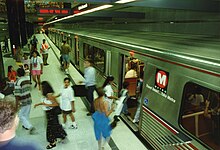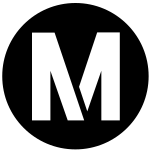|
D Line (Los Angeles Metro)
The D Line (formerly the Red Line from 1993–2006 and the Purple Line from 2006–2020) is a fully underground 5.1-mile (8.2 km)[1] rapid transit line operating in Los Angeles, running between Koreatown and Downtown Los Angeles. It is one of six lines on the Metro Rail system, operated by the Los Angeles County Metropolitan Transportation Authority. The D Line is one of the city's two fully underground lines (along with the B Line). The two lines share tracks between Koreatown and Downtown Los Angeles. As of 2019[update], the combined B and D lines averaged 133,413 boardings per weekday.[2] In 2020, Metro renamed all of its lines using letters and colors, with the Purple Line becoming the D Line (retaining the purple color in its service bullet) and the Red Line becoming the B Line. Construction is underway for a major extension of the line to the Mid-Wilshire district, Beverly Hills, Century City, and Westwood, which will add 7 stations and 9 miles of track to the line. The extension is expected to open in phases from 2025 to 2027.[3][4][5] Service descriptionRoute description The D Line is a 5.1-mile (8.2 km)[1] line that begins at Wilshire/Western station in Koreatown. The line continues east for a mile to Wilshire/Vermont station, where the line merges with the B Line. The lines continue between Wilshire Boulevard and 7th Street (and briefly Ingraham Street), where the lines interchange with the A and E light rail lines at 7th Street/Metro Center station. The lines then pass northeast through Downtown Los Angeles, passing through the Financial District, Pershing Square (near the Historic Core), and the Civic Center, before terminating at Union Station. Duplicate service on WilshireThe D Line runs below Wilshire Boulevard, which is served on the surface by the Metro Local Route 20 and Metro Rapid Route 720 bus lines. Despite the same service, Metro considers the redundant bus service justified because both routes frequently run from Downtown Los Angeles. Unlike the D Line, these bus routes run along the entire Wilshire corridor, west to Beverly Hills, Westwood, and Santa Monica. Hours and frequencyD Line trains run every day between approximately 5 a.m. and midnight. Trains operate every 12 minutes during peak hours. Early morning and night service is approximately every 20 minutes.[6]
Station listingThe following table lists the stations (including the future 7 stations) of the D Line, from west to east:
RidershipThe D Line is utilized mainly as a downtown shuttle on its shared segment with the B Line. The stub between Vermont and Western has very low ridership. According to Metro, the stub is operating 11% complete during peak hours and even lower at other times.[9] HistoryThe current D Line is the product of a long-term plan to connect Downtown Los Angeles to central and western portions of the city with a subway system. Original proposals in the 1980s had the subway line running down Wilshire Boulevard to Fairfax Avenue and then north to the San Fernando Valley. Residents in some parts of the city bitterly opposed the subway. A 1985 methane explosion at a Ross Dress for Less clothing store near Fairfax gave Rep. Henry Waxman, who represented the Fairfax District, a reason to derail the project that was opposed by his constituents by prohibiting tunneling in an alleged "methane zone" west of Western on Wilshire.[10]  The groundbreaking for the first segment of the subway was held on September 29, 1986, on the site of the future Civic Center/Grand Park station.[11] Today's D Line was built in two minimum operating segments:
The Hollywood branch (MOS-2B) began service in 1999. Initially, both branches were designated as part of the Red Line, but in 2006 trains traveling between Union Station and Wilshire/Western were rebranded to the Purple Line (changed to D Line in 2020) for greater clarity. Future expansionExtension to Westwood Metro is constructing a major extension of the D line to Mid-Wilshire, Beverly Hills, Century City, and Westwood. The new project is called the D Line Extension (formerly the Westside Subway Extension), and the first phase broke ground on November 7, 2014.[14] Metro released the Final Environmental Impact Report (FEIR) on March 19, 2012, and the first phase of the project (to Wilshire/La Cienega) was approved by Metro's Board of Directors on April 26, 2012.[15] Notice to proceed was issued to Tutor Perini on April 26, 2017 for phase two from Wilshire/La Cienega Station to Century City/Constellation Station. In Beverly Hills, there was public opposition to the D Line Extension, led by school board president Lisa Korbatov. The opposition existed because of the subway tunnel's route beneath Beverly Hills High School, and Korbatov and Beverly Hills residents were concerned about student safety issues posed by such a tunnel. Korbatov gathered around 5,300 signed petitions to send to President Donald Trump, urging him and Transportation Secretary Elaine Chao to withhold federal funding from the project. Metro ultimately won in court, but Korbatov and the school district sued in state and federal court over environmental concerns for the project.[16][17] Tunneling eventually completed in Beverly Hills in early 2022 with no issues underneath the high school.[18] Construction is now underway for all three phases of the extension, which is expected to open in segments between 2025 and 2027.[3][4][5] Proposed Arts District ExtensionMetro officials have proposed extending service on the eastern side of the D Line, allowing subway cars to continue past Union Station to service the Arts District neighborhood east of Downtown Los Angeles. D Line trains pass through Union Station, exit through a portal at Ducommun Street, and stop in the Arts District when they go to and from the Division 20 yard for maintenance and storage. Proposals have included either station at 6th Street or two stations, one at 6th Street and one at 1st Street. In 2018, the Metro board approved a $500,000 expense to undertake pre-design activities, prepare an Environmental Impact Report and conduct public engagement for a potential station at 6th Street.[19] However, it is unclear whether Metro can raise the millions of dollars of funding needed to build the proposed station.[20] One possible solution is a new tax district implemented by the City of Los Angeles that would tax a portion of property value increases in the downtown area and transfer those funds to Metro to help build the station.[21] A draft environmental impact report for the extension and station at 6th Street was undertaken beginning in March 2021.[22] OperationsOn Metro Rail's internal timetables, the D Line is called line 805. Maintenance The D Line operates from the Division 20 Yard (Santa Fe Yard) located in the Arts District at 320 South Santa Fe Avenue, Los Angeles. This yard stores train cars and equipment used on the B and D Lines. It is also where heavy maintenance is performed on the fleet. Subway trains access this yard by continuing eastward after ending their revenue service at Union Station, exiting tunnels through a portal at Ducommun Street, and then traveling south to the yard's entrance at 1st Street. Rolling stockThe D Line uses A650 75-foot (23 m) electric multiple unit cars built by Breda in Italy; these trains are based on similar vehicles that were built by the Budd Company for the Baltimore and Miami rapid transit systems between 1983 and 1986. Trains usually run in four-car during peak hours and two-car outside of peak hours. The cars are maintained in a Metro yard on Santa Fe Drive near 4th Street alongside the Los Angeles River in Downtown Los Angeles. In March 2017, Metro ordered 64 CRRC HR4000 railcars, some of which will operate on the D Line when the D Line Extension is completed.[23] In January 2024, Metro ordered 182 Hyundai Rotem HR5000 trains, allowing for future replacement of all Breda A650 trains, expanded train service including a four minute train frequency, and extensions of the D Line over three phases.[24] References
External linksKML is from Wikidata
Wikimedia Commons has media related to D Line (Los Angeles Metro).
|
||||||||||||||||||||||||||||||||||||||||||||||||||||||||||||||||||||||||||||||||||||||||||||||||||||||||||||||||||||||||||||||||||||||||||||||||||||||||||||||||||||||||||||||||||||||||||||||||||||||||||||||||||||||||||||||||||||||||||||||||||||||||||||||||||||||||||||||||||||||||||||||||||||||||||||||||||||||||||||||||||||||||||||||||||||||||||||



